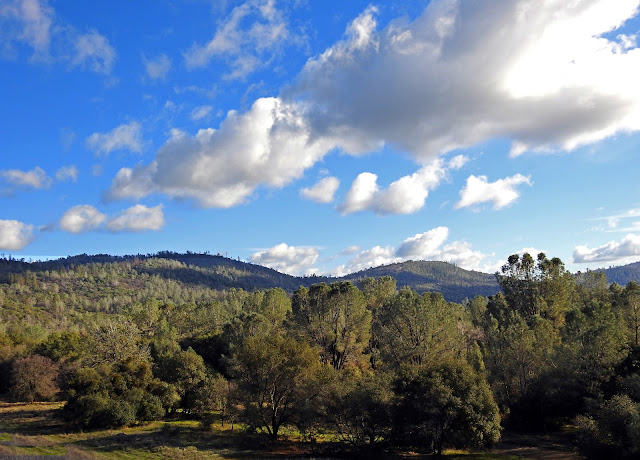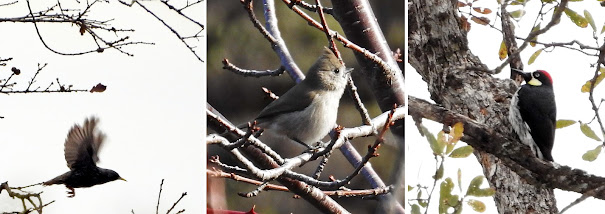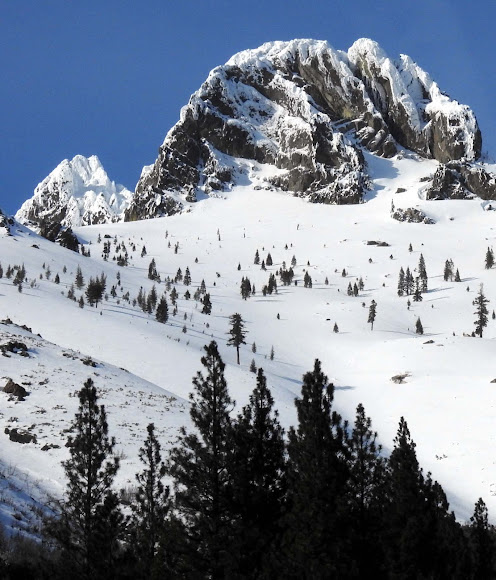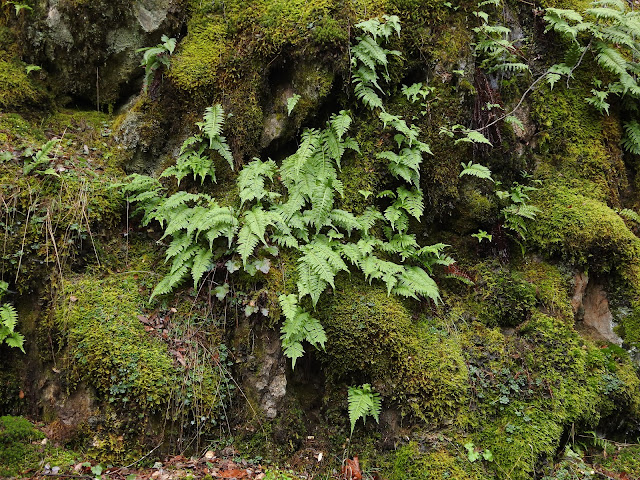
Bald Eagle - Haliaeetus leucocephalus
Just the other morning, as I was leaving to go on a hike, I spotted a Bald Eagle drying out it's wings along the river corridor! WOW!!! We had just had a week of very rainy days, with a total of 4.47" of rain! This spectacular Bald Eagle was spreading its wings on a misty but not rainy morning, attempting to dry them out! How beautiful!
We had JUST seen an immature Bald Eagle last week at Gray Lodge! I hadn't seen a Bald Eagle on our river for more than a year! What rare sightings I've enjoyed lately! Both male and female Bald Eagles look alike, and will have a white head and tail when 4-5 years old. They have a lifespan of 28-38 years in the wild.
Bald Eagle - Haliaeetus leucocephalus
The following information is from the Cornell Ornithology Lab website https://birdsoftheworld.org.
"The Bald Eagle is monogamous and thought to mate for life unless a mate dies, but this is not well documented. They undertake spectacular courtship rituals annually, involving loud vocalizations and acrobatic flight displays. Perhaps the best known courtship act is the Cartwheel Display, in which a courting pair fly to a great altitude, lock talons, and tumble/cartwheel back toward earth, separating just before collision with the ground!
Both sexes contribute to nest building, although the female may place the sticks within nest. Once initiated, nest-building may take up to 3 months to complete, although nests may be completed in as little as 4 days. Additional materials are regularly added to the nest throughout the year, including daily additions during the breeding period, so that nests used for multiple years may achieve enormous dimensions. Typical nests are 1.5–1.8 m in diameter and 0.7–1.2 m tall, and the nest shape conforms to shape of tree, ranging from cylindrical or cone-shaped to flat."
Red-tailed Hawk - Buteo jamaicensis
There aren't a lot of raptors in our area. In fact I have mainly been seeing one Cooper's Hawk, and one Red-tailed Hawk. New this week a Red-shouldered Hawk and the above Bald Eagle have shown up! Each hawk has a specific diet in the winter, such as birds, birds and mammals, or just mammals. I imagine that it's not easy for these raptors to find enough to eat! The heavy rain has made it even more difficult to catch prey, as explained in the following quote from gckcopywriter.com.
"Raptors like rain about as much as a cat likes a bath. Hawks, eagles, owls, and other birds of prey have a tough time during drenching rains.
First, depending on their size, a raptor’s wings can take as much as an entire day to dry out. Before that, it’s too difficult to fly any normal distance to find food. Second, even if they can fly normally, their prey – whether its smaller birds, rabbits, or squirrels – take shelter against storms in dense surroundings or burrows. They stay hidden. If it rains too long, raptors can be faced with a serious lack of food and face a real crisis."
Red-tailed Hawk - Buteo jamaicensis
The handsome Red-tailed Hawk above was perched in a tree very close to the tree I saw the Bald Eagle in! It's probably the same Red-tail that I've seen several times this winter in our neighborhood. It flew away shortly after I spotted it, revealing it's lovely orange-brown
chest, belly, and tail!
Cooper's Hawk - Red-shouldered Hawk
Accipiter cooperii -Buteo lineatus
I also saw a Cooper's Hawk and a Red-shouldered Hawk this week! The Cooper's Hawk may be the one I've been seeing in our neighborhood lately, but the Red-shouldered Hawk is new. Red-shouldered Hawks used to live exclusively down in the foothills and delta areas of California. They have recently expanded their territory to include our river, at around 2,500' in elevation. Riparian areas are their preferred habitat. Red-shouldered Hawks eat reptiles, amphibians, small mammals, and occasionally birds, such as Mourning Doves, House Sparrows, and Starlings. I have never seen them at higher elevations. Both of these hawks are on the smallish size having approximately 16.5" in length, with wingspans under 40", and a weight of a little more than a pound.
Merlin - Falco columbaris
In my December 1, 2023 blog, I posted a photo of the bird on the left, and identified it as a Peregrine Falcon! I have since posted it on iNaturalist.org where it was immediately identified as a Merlin. My mistake, but how cool! I've only seen a Merlin one other time in my life (the bird on the right), and it was in our neighborhood! Merlins are way smaller than Peregrine Falcons, and their "mustaches" are way less defined than a Peregrine's mustache! The "mustache" is the dark bar or shape that extends down the neck from the corner of their eye. There are also regional variations in mustaches, with some mustaches being broad instead of narrow. Their feathering is quite different as well. Boy was I OFF on this identification!!!
Peregrine Falcon - Falco peregrinus
I've included this photo of a Peregrine Falcon that I took 5 years ago. These falcons are 16" in length, have a wingspan of 41", and weight of 1.6 lb. Merlins on the other hand, are only 10" in length, have a wingspan of 24", and a weight of 6.5 oz!
Collin's Lake 1-25-24
Daugherty Hill Wildlife Area via Collin's Lake
We had a nice break in some rainy weather, so my friend Nancy and I drove down to Collin's Lake to hike into the Daugherty Hill Area. We hadn't explored this part of the Daugherty Hill Area before. It was a gorgeous blue-sky day with beautiful, puffy, white clouds abounding! Yay!
Collin's Lake is a BIG lake! Wikipedia states: "Collins Lake, impounded by Virginia Ranch Dam, is a freshwater man-made lake with a surface area of 1,009 acres located in the foothills of the Sierra Nevada Mountains north of Sacramento, California. The lake was originally created to provide additional irrigation water to Browns Valley and Loma Rica. It still serves that purpose as well as a recreation and fishing lake. In 1960, the building of a 152-foot (46 m) high embankment dam was started, which would create a lake with a 57,000 acre-feet capacity. The dam was finished in three years."
To get to the hiking trail, we had to walk across the dam, which afforded a gorgeous view of the lake! On the way we saw several waterfowl, including a Double-crested Cormorant and a Pied-billed Grebe in non-mating colors.
Double-crested Cormorant - Pied-billed Grebe
Phalacrocorax auritus - Podilymbus podiceps
Common Mergansers (female-male) - Mergus merganser
Daugherty Hill Wildlife Area
The Daugherty Hill Wildlife Area is a Blue Oak/Gray Pines woodlands. Right now nothing is in bloom, but it's really greening up from the recent rains. The trail wasn't too muddy and the views were incredibly beautiful with all the clouds!
Pine Siskins - Spinus pinus
We lucked out and saw Pine Siskins several times throughout the day. They are always in flocks of 30 to 100+ birds, and it's amazing to watch them fly and land together in a bunch. They also chatter a lot, and are one of the main "events" I look forward to seeing in the winter! Throughout the year they mainly feed on seeds, as well as small insects and spiders!
European Starling - Oak Titmouse - Acorn Woodpecker
Sturnus vulgaris - Baeolophus inornatus - Melanerpes carolinus
In one part of the area we heard, but didn't see, a LOT of birds making a racket! We looked and looked but had no luck spotting them. Then, all of a sudden in the far distance we saw a whole huge flock of biggish birds take off from a tree! I managed to get one shot before they disappeared, and I'm pretty sure it is a European Starling! These birds are invasive, non-natives that can be a problem. The following information on Starlings is from https://birdsoftheworld.org.
"The success of the European Starling in North America is nothing less than phenomenal. Although estimates vary, it is commonly believed that a total of about 100 individuals was released into Central Park, in New York City, in 1890 and 1891. The entire North American population, now numbering more than 200 million and distributed across most of the continent, is derived from these few birds. This is arguably the most successful avian introduction to this continent.
Although the European Starling is most frequently associated with disturbed areas created by man, it has had a significant impact on our native avifauna. In particular, it offers intense competition for nesting cavities and has had a detrimental effect on many native cavity-nesting species."
We hope they don't become a common sight at Daugherty Hill!
Oak Titmice are year-round residents of the foothills. They feed on plants, seeds, and insects. The following information is from https://birdsoftheworld.org.
"Oak Titmice are closely tied to open oak (Quercus) or oak–pine (Quercus–Pinus) woodlands. Indeed, the species is among the most common bird species in the oak woodlands of California, the “voice and soul of the oaks”. They are highly vocal, and individuals are most commonly recognized by the chatter-like calls which males and females utter throughout the year. Males may sing infrequently during the nonbreeding season, with singing intensity increasing toward spring.
Pair bonds form during the first year and are usually permanent. Natural or woodpecker-excavated cavities are used for nesting, and clutches typically contain 6–7 unmarked eggs. The diet is varied, and the species is known to cache food. Oak Titmice are sedentary and defend territories throughout the year."
Western Bluebirds (male - female) - Sialia mexicana
We always see the brilliant Western Bluebirds when we're at Daugherty Hill, usually feeding on mistletoe berries. They may live here year-round, or may migrate uphill in the Spring. The following information is from https://birdsoftheworld.org.
"Insectivorous during the warmer months, individuals forage primarily on berries and fruits through the winter; wintering individuals are especially abundant in years and in areas when mistletoe and juniper berry crops are plentiful."
Leafless California Black Oak with Mistletoe clumps showing - Quercus kelloggi
Winter is the perfect time to see all the Mistletoe in the bare, leafless oak trees. Mistletoe is a hemi-parasitic plant, in that it does produce its own chlorophyll while simultaneously obtaining carbon from its host plant. It will not kill it's host. Many, many critters eat mistletoe berries in the winter. They are one of the main food sources for foothill wildlife.

Grizzly Peak in the Mists
We got a lot of rain this week, and our water year total is up to 20.15", about one third of the total average amount. Yay! More rains, and maybe some snow are in the forecast for the coming week! Fingers crossed!
Misty forested ridges
What's happening up in the Lakes Basin?
What's happening with the local mosses, ferns, and lichens?
Check back next week for the answers to these questions and more!
Your questions and comments are always welcome, please email me at northyubanaturalist@gmail.com.































.jpg)




















